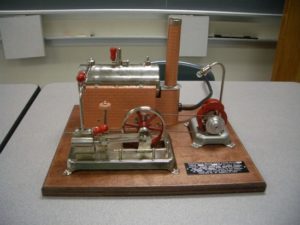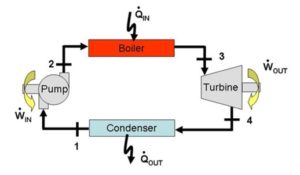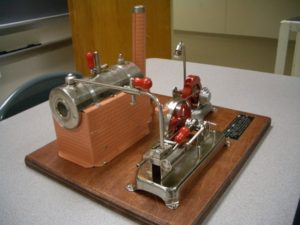Model Description
This is a demonstration of the fundamentals of the vapor power cycle in that it translates the internal energy of steam into mechanical then electrical power. This demonstration falls short of demonstrating the true vapor power cycle in that the steam is not returned to the boiler; instead it is vented as exhaust. This demonstration should take 10-15 minutes.

Engineering Principle
The Rankine cycle seeks to transfer thermal energy into mechanical energy. The basic components necessary for a Rankine cycle are highlighted below.

Starting at point 1 where the liquid water emerges from the condenser, the pump increases the pressure to point 2. The boiler transfers a great deal of thermal energy into the liquid causing a large increase in enthalpy and a phase change to superheated vapor. The turbine uses this high enthalpy at the inlet (state 3) to turn the turbine blades and produce work. The vapor at state 4 then passes through the condenser returning the fluid to a liquid.
In this demonstration, there is no condenser or pump. The water in the reservoir is heated to the point of steam and travels from the boiler through the piston cylinder device. After creating work out of the system, the steam vents as exhaust. Once the reservoir is empty the steam engine can no longer produce work. This is sufficient however to demonstrate the conversion of thermal energy into mechanical work and then electrical work.
What You Need
| Item | Quantity | Description/Clarification |
|---|---|---|
| Steam Engine | 1 | Not widely available. Jensen Manufacturing (www.jensensteamengines.com) and Wilesco (www.wilesco-steam.co.uk) have a large selection of hobby and educational steam engines. Recommend purchasing a steam engine that is electrically heated as compared to powered by dry fuel (i.e. Sterno). |
How It’s Done
Before Class: Fill up the water reservoir. Plug in the device to allow it time for the boiler to create steam. This process can take up to ten minutes so plan accordingly. Have paper towels ready to clean up the steam exhaust. Some of these steam engines will allow you to boil the water but not release it to the piston until you are ready for the demo.

In Class: Open the valve to allow the flow of steam to the piston and flywheel. It may require that you spin the flywheel to get it started. After the flywheel is moving the piston will convert the thermal energy from the steam into the mechanical energy required to move the piston and turn the flywheel.
Observations: Students should be able to visualize the conversion of energy from electrical energy required to heat the water to thermal energy required to move the piston to mechanical energy required to turn the flywheel.
Additional Application: Several of these devices are connected to a light bulb via an electric generator to further illustrate the conversion of mechanical energy to electrical energy.
If you unplug the steam engine, the thermal energy stored in the steam is still sufficient to power the piston for several more minutes. Discuss why.
The speed of the piston and flywheel increases if you disconnect the light bulb. Discuss why.
